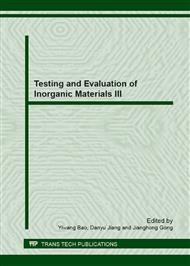[1]
T.K. Gupta, Application of zinc oxide varistors, J. Am. Ceram. Soc. 73 (1990) 1817-1840.
Google Scholar
[2]
S. Fujitsu, H. Toyoda, H. Yanagida, Origin of ZnO varistor, J. Am. Ceram. Soc. 70 (1987) C71-C72.
Google Scholar
[3]
Y.S. Lee, T.Y. Tseng, Phase identification and electrical properties in ZnO-glass varistors, J. Am. Ceram. Soc. 75 (1992) 1636-1640.
DOI: 10.1111/j.1151-2916.1992.tb04236.x
Google Scholar
[4]
K. Mukae, Zinc-oxide varistors with praseodymium oxide, Ceram. Bull. Vol. 66 (1987) 1329-1331.
Google Scholar
[5]
H. Feng, Z.J. Peng, X.L. Fu, et al, Effect of TiO2 doping on microstructural and electrical properties of ZnO–Pr6O11-based varistor ceramics, J. Alloys compd. 497 (2010) 304-307.
DOI: 10.1016/j.jallcom.2010.03.047
Google Scholar
[6]
H.H. Hng, K.M. Knowles, Microstructure and current-voltage characteristics of praseodymium- doped zinc oxide varistors containing MnO2, Sb2O3 and Co3O4, J. Mater Sci. 37 (2002) 1143-1154.
Google Scholar
[7]
C.W. Nahm, Influence of cobalt oxide addition on electrical properties of ZnO-Pr6O11-based varistor ceramics, J. Mater. Sci. 40 (2005) 1265-1267.
DOI: 10.1007/s10853-005-6948-7
Google Scholar
[8]
S.S. Lin, J.G. Lu, Z.Z. Ye, et al, p-type behavior in Na-doped ZnO films and ZnO homo junction light-emitting diodes, Solid State Commun. 148 (2008) 25-28.
DOI: 10.1016/j.ssc.2008.07.028
Google Scholar
[9]
C.W. Nahm, Microstructure and electrical properties of Tb-doped zinc oxide-based ceramics, J. Non-Crystall. Solids 353 (2007) 2954-2957.
DOI: 10.1016/j.jnoncrysol.2007.06.041
Google Scholar
[10]
B.S. Skidan, M.M. M'int, Effect of metal oxides on the microstructure of Zinc ceramic, Glass and Ceramics 64 (2007) 31-33.
DOI: 10.1007/s10717-007-0008-5
Google Scholar
[11]
T. Watari, R.C. Bradt, Grain growth of sintered ZnO with alkali oxide additions, J. Ceram. Soc. Jap. 101 (1993) 1085-1089.
DOI: 10.2109/jcersj.101.1085
Google Scholar
[12]
A. Yavuz Oral, Z. Banu Bahsi, M. Hasan Aslan, Microstructure and optical properties of nano crystalline ZnO and ZnO: (Li or Al) thin films, Appl. Surf. Sci. 253 (2007) 4593-4598.
DOI: 10.1016/j.apsusc.2006.10.015
Google Scholar
[13]
L.G. Yu, G.M. Zhang, X.Y. Zhao, et al, Fabrication of lithium-doped zinc oxide film by anodic oxidation and its ferroelectric behavior, Mater. Res. Bull. 44 (2009) 589-593.
DOI: 10.1016/j.materresbull.2008.07.003
Google Scholar
[14]
E.C. Lee, K.J. Chang, p-type doping with group-I elements and hydrogenation effect in ZnO, Physica B 376-377 (2006) 707-710.
DOI: 10.1016/j.physb.2005.12.177
Google Scholar
[15]
C.W. Nahm, Effect of sintering temperature electrical properties of ZNR doped with Pr–Co–Cr–La, Ceram. Intl. 34 (2008) 1521-1525.
DOI: 10.1016/j.ceramint.2007.04.014
Google Scholar
[16]
J. A. Park, Effect of Al2O3 on the electrical properties of ZnO-Pr6O11-based varistor ceramics, Physica B 403 (2008) 639-643.
DOI: 10.1016/j.physb.2007.09.068
Google Scholar


